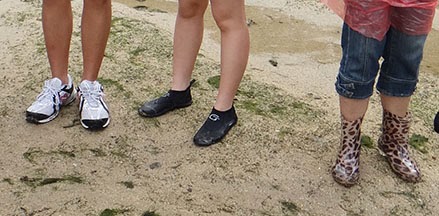What should I be aware of?
Not all have facilities: Besides Sentosa and Labrador Beach, the
more remote islands only have basic facilities (toilets, shelters). Bring
along all your needs: food, drinking water and other essentials. Please
do not litter. Bring back all your litter and dispose of it on the mainland.
Do not leave valuables unattended on the shores.
Safety first
Watch the tide: Don't go far out if you are not familiar with the
tides. Your route back to the shore might get cut off by the incoming
tide.
Watch the weather! Lightning is dangerous. It can occur without rain. If the weather turns ominous, quickly go to one of the many shelters equipped with lighting protection. If you hear lightning, IMMEDIATELY seek shelter. And do not go out again until lightning has stopped for some time (half an hour is a good gauge). You are most vulnerable on the flats but lightning can also strike among the trees. Do not shelter under trees, under cliffs.
- Lightning: the scariest thing on the shores more details on the wild shores of singapore blog.
- Stormy shores: The Sumatras more about these violent storms, on the wild shores of singapore blog.
- Check the weather forecast at the National Environment Agency's Meteorological Services website's Nowcast and Forecast which has a 3-hour to 3-day outlook for various locations in Singapore.
Dangerous animals: Dangerous animals such as stonefish, stingrays
and sea snakes are still common on our shores. Many soft-looking animals
on the shores protect themselves with toxins which can cause rashes. You
may also get hurt if you touch your eye or mouth after touching toxic
animals. Most animals have a way to defend themselves in unpleasant ways.
Some can sting through even booties and hard soled shoes.
The best way to avoid injuries
| May be fatal | May be very painful | Can be harmful | Can bite/pinch |
|
Stonefish |
Jellyfish Hydroids Sea urchins |
Sponges Zoanthids Octopus |
Crabs Fishes |
 Don't climb the rocks: Rocks are slippery
with algae and covered with sharp barnacles that can give nasty cuts that
take a long time to heal. A nasty fall may result in broken limbs and
concussion.
Don't climb the rocks: Rocks are slippery
with algae and covered with sharp barnacles that can give nasty cuts that
take a long time to heal. A nasty fall may result in broken limbs and
concussion.
Don't step into areas with soft
mud: You may lose your shoes and then step on something unpleasant.
Prepare properly
for your shore trip
Proper preparation makes for an enjoyable visit to the shores.
Poor preparation can make the trip miserable and unpleasant. So take some
time to prepare!
Do NOT go barefoot
on the shores!
 Do
NOT wear these on the shores:
Do
NOT wear these on the shores:
- Open sandals expose your bare foot to all kinds of hazards. From broken glass, sharp litter, annoying critters to hookworm larvae.
- Shoes without laces (e.g., with velcro) are not secure in mud.
- Flip-flops will fall apart in the least bit of mud.
Do NOT walk with
your shoes encased in plastic bags. This reduces the grip of your
shoes on the ground. The ground can be slippery with seaweed and mud.
You may then fall and not only get mud all over yourself (not just your
shoes), but you may also get injured.
Other
useful items to bring
- Extra pair of footwear
to change into for the journey home.
- Hat to protect
from the sun. It can get hot on the flats on a sunny day.
- Enough drinking
water. Ideally, 1-2 litres per person for a day trip.
- Raingear (raincoat, poncho) and plastic bags for electronic items.
- Sunscreen: the
sun can be particularly strong on a sunny day. See Natural
Hazards: Sunburn on the wild shores of singapore blog.
What
should I do to prepare myself for the visit?
Before your walk have
a good night's rest, drink plenty of water and have your regular meal.
If you are not feeling well, do not go for the visit.
MORE information
Special tips for photographers
visiting the shores.
Here's more on general preparations
for a visit to the wild.
More FAQs
on shore visits.
|
Are
you ready for a safe trip on the shores?
Try this quiz! |
||
Join a guided walk!
Instead of going on your own, why not join a guided walk!
The best way to experience and learn about the shores is to visit with an experienced guide.
See more! Guides are familiar with the terrain and seasons of the shores. They can show you more during the short window of low tide. They can also tell you more about what you see so you can learn more.
Be safe: The shores are not dangerous if you know what you are doing, but for the unfamiliar there are potential hazards. With a guide, even young children can interact safely with the shores.
Minimise your impact: Every inch of the shores are alive with small animals and growing plants. A guide will help you see more and yet minimise the impact of your visit.
Have a great time! Guides are eager to ensure you have an enjoyable visit. Whether you are just there to see what's so special about the shores, or if you need more details for a project or have a special area of interest. Do tell your guide, who will gladly try to help you.
Join exciting public guided walks at these locations!
Chek Jawa
Kusu island
Pulau Semakau
Sentosa
Want to organise a trip just for your group at your preferred time, see this list for some contacts.
Links
- Introduction to visiting mangroves from the online Guide to the Mangroves of Singapore: details of preparations and what you might see during a mangrove visit.
- Preparing for a visit to the shores on the online Guide to the Seashore Life in Singapore.
- Warning,
venture at your own risk
By Chang Ai-Lien The Straits Times 9 Aug 05
YOU'RE more likely to get hit by a car than attacked by a wild animal in Singapore. But it could happen. We present the how-not-to-get-yourself-killed/maimed/ poisioned guide to enjoying the outdoors - Watch
Your Step: Study Shows Life in Tidal Areas at Risk
John Roach National Geographic website, 25 Jul 05 - Why you should not walk barefoot in the sand: hookworm larvae, jellyfish and sandfly bites on the wild shores of singapore blog.
- Sandflies: bane of our shores on the wild shores of singapore blog.

